Country Report: Argentina
With a track record of surviving successive economic crises, the battle-tested Argentinian pharma industry has developed into a powerful leader in markets across the Latin America region.
This sponsored supplement was produced by Focus Reports.
Publisher: Ines Nandin
Project Director: Emilie Laumond
Editorial Coordinator: Alexander Ackerman
To read exclusive interviews, visit www.pharmaboardroom.com
ARGENTINA: Beating the Cycle
Argentina has experienced six severe economic crises since the great depression, and as a result, Argentinians have become excellent problem solvers. With extensive scientific and engineering expertise, creativity and ambition, the industry has established a pattern of strong growth in times of plenty, and minimizing losses during periods of inflation and recession, in effect "beating the cycle." Along the way, the top Argentinian labs have developed into a powerhouse pharmaceutical industry that rivals the multinational sector domestically, and has taken a position of leadership in markets across the region.
A LOCAL'S MARKET
Truly diamonds in the rough, the top Argentinian pharma and biopharma laboratories are forces to be reckoned with wherever they do business. "Argentina is one of the few nations worldwide that has a domestic pharma industry that dominates the international pharma sector in terms of revenue; seven out of the ten top firms are Argentinian, and 60 percent of the market value is sold by Argentinian laboratories," explains Francisco Cervo, the general manager of Elea. Patrice Fuster, the general director of Sanofi Argentina, clarifies that these national companies "are not nationals in the traditional sense, as they are giants; they are regional companies, exporting their products around the world. They have an extremely strong presence and are very competitive in Argentina, and their brands are incredibly strong." One of these domestic giants, Roemmers, stands significantly above the rest, with more than nine percent of the market, nearly twice that of the next highest grossing competitor, Bagó. Argentia, a company of the Roemmers group led by Esteban Echenique, entered the nutraceutical market after the acquisition of Metabolic Cla and recently incorporated Menarini's products into their portfolio, another example of the dynamism of the Roemmers Conglomerate, lead by Eduardo Macchiavello, CEO, Roemmers. Echenique explains their strategy : "to focus on chronic products, the cardiology area mainly focused on antibiotics, and with our cardio branch our market share grew from the 13th largest to the 8th (and climbing) at this point in time." Argentia is the fastest growing company in the IMS ranking of the 50 biggest companies in Argentina.

Upwind Beating Credits: Publisher
This market is also unique within the region, as it has developed as a branded generics market with very low pure generics participation, at just ten percent according to IMS, the lowest level in the region. Norberto Bonaparte, the founder and CEO of Close Up International, explains that "until 2002, physicians could legally prescribe a specific branded product, and today a brand name is usually included alongside the generic name on the prescription." As such, "most labs carry out extensive and dynamic marketing strategies and actions," according to Bonaparte, and Eduardo Neira, country president for AstraZeneca Argentina, says Argentina has a "consumer driven market that pays more interest to brands rather than new molecules," because the brand is seen as a "stamp of quality."
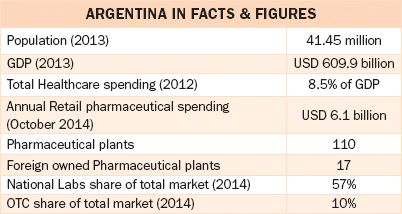
ARGENTINA IN FACTS & FIGURES
The significance of brands to the Argentinian consumer, and the strength of many of the top Argentinian brands, has limited the ability of multinational companies to penetrate the market on their own. According to Ernesto Felicio, the executive director of the research-based pharmaceutical industry association CAEMe, which is celebrating its 85th anniversary in 2015, there has been "an increase in joint initiatives between local and international companies" in recent years; many of these joint initiatives have taken the form of product licensing and co-marketing agreements. Mariano Sanchez, lead healthcare partner at KMPG Argentina, explains "the increasing prevalence of distribution and licensing agreements between multinational and Argentine laboratories" is the result of several policies that caused local labs to build "better distribution and marketing infrastructure and [made] investing in manufacturing capabilities in Argentina" less attractive to outside investors.

Esteban Echenique, General Manager, Argentia
In today's market, "multinational companies often want to launch products in countries like Argentina, but lack the sales force to properly market the products," Cervo explains. "Since only the top five or six firms have sufficiently large sales teams," he continues, "there are only a few competitors for this [co-marketing/licensing] business that we must contend with overall, across all therapeutic areas." The demand for local partners is so great, that for Gador, "in Argentina, nearly 40 percent of our sales are licensed products at this point," according to the company's general director, Luis Rodriguez.
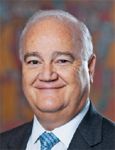
Alberto Alvarez Saavedra, President, Gador
PHARMACEUTICAL EXCEPTIONALISM
"The pharmaceutical industry has been one of the most dynamic sectors in the Argentinian economy, and is now an engine of economic growth, employment, scientific knowledge and applied technology," says Alfredo Chiaradia, the general director of CILFA, the chamber of Argentinian pharmaceutical industry that recently celebrated its 50th anniversary. "Pharma in Argentina comes from a very rich and deep-rooted tradition, triggered by the early emergence of many national family businesses, many of them now over 100 years in the country. All that was achieved in spite of the frequent volatility associated with the evolution of the economy at large." Janssen's finance director for Janssen Latin America South, Alejandro Smolje, assures that this pattern still continues, saying "in spite of the country's often volatile economy, the industry has enjoyed adequate growth over the past few years."

Luis Rodriguez, Director General, Gador
While the industry has outperformed other sectors in recent years, Mariano Sanchez, the partner in charge of healthcare at KPMG Argentina, points out a few external and structural factors that have contributed to the industries success. "Following the crisis in 2001," he explains, "a significant number of multinational pharmaceutical companies started to sell their production facilities in Argentina," and a few years later the government "put in place the controls on imports that we see today, and instituted the 'national preference' policies in many parts of the healthcare industry." As a result, "some of the larger local companies were able to acquire high-tech manufacturing facilities from multinational companies at liquidation prices, and then were given a privileged position in the market and protected from foreign competition." The pharma industry also benefits from several other governmental support measures, including low rate investment credits awarded for Argentina's bicentennial in 2010 and scientific, engineering and financial support for R&D from the ministry of science and technology, and the national research council (CONICET).
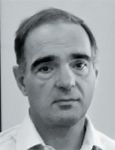
Francisco Cervo, Director General, Elea
Offsetting these measures of support however, are the price controls on pharmaceutical products, which have not adequately taken into account the effect of the country's high inflation rate. "For several years, the price of pharmaceutical products in Argentina has been lagging behind the increase of prices of everything else (raw materials, salaries, etc.)," says Juan Pablo Bagó, the general director of Grupo Bagó's pharmaceutical business in Argentina. "With the inflation rate of around 25 to 27 percent per year [over the last four years], prices of medicines have only increased by an average of 14 percent per year," Bagó explains. With profit margins being squeezed, quarterly price negotiations with the ministry of economy and public finance led by Augusto Costa, the secretary of commerce, are of critical importance for vendors, and the chambers representing the industry in these negotiations-CILFA, CAEMe, and COOPERALA-have seen their responsibility increase substantially. However, Daniel Varde, Deloitte's head of healthcare and life sciences for Latin America, notes that while margins "have been shrinking, they are still reasonable," because Argentinian "prices are quite high relative to other countries."
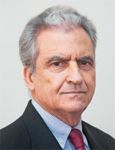
Emb. Alfredo Chiaradia, Director General, CILFA
However, as Varde also admits, "surviving in this environment has forced companies to overhaul their strategy, so that they can effectively reduce costs, or at least limit their growth, without losing revenue." Furthermore, he argues that while reducing costs, "it is critical for companies to grow their revenues by launching new products and developing more exports," which provide the added benefit of revenue diversification. However, he also points out the fact that developing these revenues means "there are R&D, registration, and marketing costs that cannot be cut and in some instances, must be increased in the short term." Accordingly, several CEOs have quoted aggressive goals for export growth, with Lab Richmond aiming to exports from 14 to 50 percent of revenue in the short-term, Gador hoping to increase substantially from 20 percent, and Bagó planning on reaching 75 percent from their current level of 45.
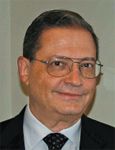
Ernesto Felicio, Executive President, CAEMe
The OTC segment is another area that holds a lot of potential for growth in the Argentinian pharma market, as this segment only accounted for 10 percent of total retail revenues in 2012. Bagó says that the share of OTC products will "increase on an annual basis," and that "the current market situation is not due to regulation," but the fact that "very few companies are currently focused on the OTC market." German Heiken, the general manager for Genomma, agrees, and points out "companies like us, mainly focused on OTC products, are quite rare in Argentina." Bagó sees this gap in the OTC market as a key opportunity for the firm's growth, and as such the group is "investing more than ever in this type of product," and he is confident that "in the near future OTC will be definitely one of our leading lines in the Argentinian pharma market."
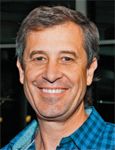
Eduardo Neira, Presidente, AstraZeneca
HEALTH & PHARMA "ARG-ECONOMICS"
Consisting of a patchwork of overlapping insurers, providers, and often-inconsistent systems, the Argentinian healthcare system is closely entwined with the local industry and the incentives of multinational players. In reality, the system is fragmented along more than just geographical lines as there there are three separate systems of healthcare providers: the public systems (managed independently within each province) including public hospitals and health centers, the private health system, and a system of healthcare centers operated by Pami, the Argentinian social security health insurance agency for senior citizens. While Pami and the public system are self-funded, private healthcare services are covered by both private insurance providers and union-based health insurance plans called "obras sociales" or "social work insurance," which are themselves generally outsourced to private insurers. Raul Pistorio, executive director of Farmalink, clarifies that currently, "healthcare coverage level is as follows: 46 percent through agents of social security, 39 percent some of the different services provided by the public sector, and finally about 15 percent the private sector."
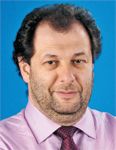
Alejandro Smolje, Finance Director, Janssen
According to Mariano Sanchez, partner in charge of healthcare at KPMG Argentina, this fragmentation has reduced the efficiency of healthcare spending, indirectly contributing to the system's high levels of debt and payment risk for pharmaceutical players. He highlights several structural and procedural inefficiencies, pointing out that when the unions outsource the 'obras sociales' to private insurers, "there is an extra margin generally included by the union," and that "in many cases people are covered by more than one payer, yet there is no harmonization between the systems."

Maria Gabriela Pittis, Country Manager, Shire
However, despite posing certain risks to the pharmaceutical industry, the healthcare system itself offers an excellent standard of coverage to Argentinians. Healthcare spending was 8.5 percent of GDP in 2012, according to the World Bank, and Brazil and Uruguay are the only Latin American countries to surpass this level of spending, at 9.3 and 8.9 percent respectively. "Access to medicine in Argentina is among the best in the world," explains Hugo Sigman, CEO of Grupo Chemo and its parent company Grupo Insud. "On one hand, there are many national programs that help the population to receive medicine, such as Plan Remediar, which supplies 40 million free units to health centers around the country, as well as Plan Nacer. The government delivers free medicine to 100 percent of people with AIDS, chagas, and other illness. Additionally, if you are a patient in a hospital you receive free medicines. Today, there are 18 compulsory vaccines in Argentina that are free, universal and obligatory. All citizens with pensions receive free medicines or medicines with minimal cost."
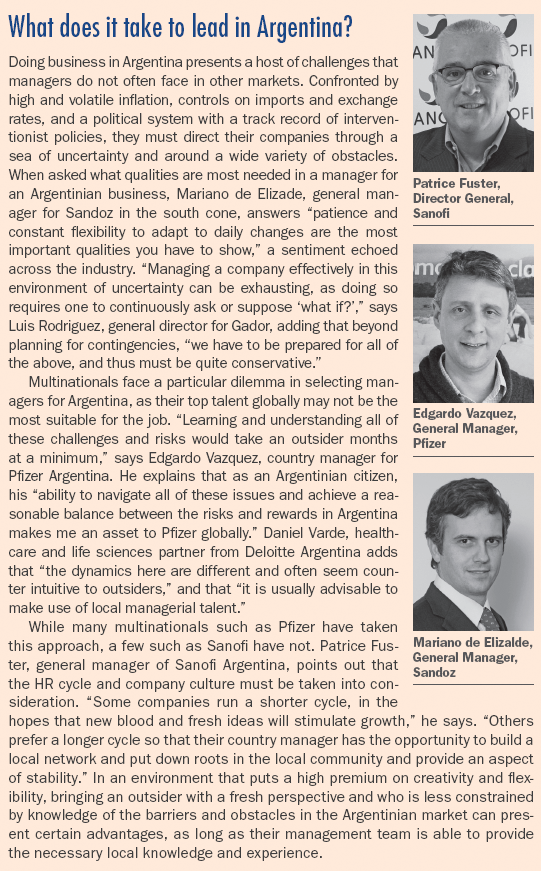
What does it take to lead in Argentina?
Regarding access to innovative and high-cost treatments specifically, "many Argentine citizens today have access to specialty or high technology products due to a solid reimbursement system," explains Alejandro Smolje, the finance director for Janssen Latin America South. "Through HMOs, more than 70 percent of the population has access to these high tech products. This is not unique, but certainly different from the situation in many other Latin American countries." Smolje also adds that Janssen has "been able to launch new, innovative and high-quality products on numerous occasions due to an emphasis on a long-term strategy focused on unmet medical needs," and Eduardo Neira, country president for AstraZeneca Argentina concurs, saying "market access in Argentina is outstanding: we are often among the first countries [worldwide] when it comes to new drug releases."
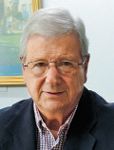
Dr. Raul Pistorio, Executive Director, Farmalink
Among the innovative and often high cost treatments that the Argentinian healthcare system is able to provide, the government has recently made progress with regards to orphan drugs for rare diseases. "Argentina passed a law in 2011 that is still being implemented, which explicitly requires the private and social insurance organizations to provide support for rare disease treatment," explains Gabriela Pittis, the general manager for Shire Latin America South. Furthermore, recognizing the "phenomenon unique to rare diseases, which is that through Internet research and participation in patient associations, the patients quickly come to know far more about their condition" and its management "than most of their physicians, health management organizations, and regulatory authorities." The same law "created a central committee, which includes patients as members, to coordinate activities such as neonatal screening and patient registries." Overall, she concludes, "progress in Argentina is moving more quickly than in many other countries in the region, and current treatment standards are very high."
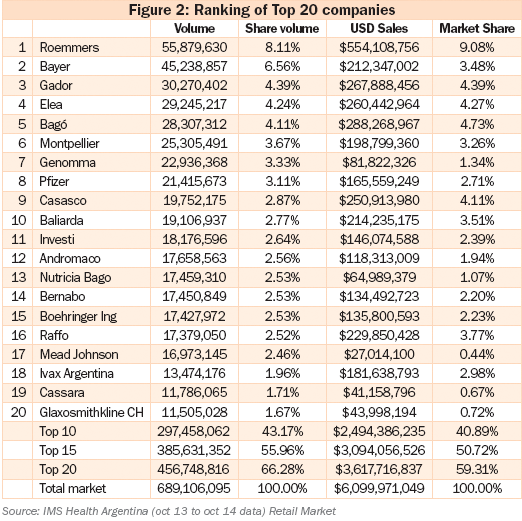
Figure 2: Ranking of Top 20 companies
NEXT STOP ON THE EXPORT EXPRESS; FIRST WORLD MARKETS
According to Federico Trucco, CEO of Bioceres, Argentina's "strong tradition in biological sciences" is a key factor behind the success of the country's domestic pharma companies at the regional level in recent years. As "the only country in Latin America with three Nobel laureates in the field," the country has a large "pool of talent, who lead in biopharmaceuticals because of their renowned expertise," that the pharma and biotech industry has recruited heavily from. Antonio Bouzada, president and founder of Eriochem, reinforces this claim by saying that "our biggest asset is our strong pool of human resources, and the cultural commitment to excellence in work; business might not be the most efficient or professional in Argentina, but when people are expected to meet a certain level of quality in their work, they meet it," allowing this company and many others "to achieve and maintain the standards necessary to export to some of the more regulated markets."

Regional Leadership Beyond the Private Sector
Trucco also says that he believes the industry's core strength has been in "producing existing technology at a lower cost with high quality," and "pursuing state-of-the-art pharmaceuticals to generate competitive production platforms," and Bouzada hopes that "in the future, we will be able to leverage these strengths [in production technology] and take a strong position as generic players in the more regulated markets." "The problem for the other markets," he says "is that our products are neither the cheapest, nor the very highest quality." This trade off has encouraged many Argentinian firms to pursue niche product types and difficult-to-produce products, including added-value generics, also known as super-generics, and biosimilar APIs and products, as their higher operational costs are less of a disadvantage in these underserved and technologically demanding areas.
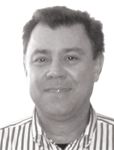
Carlos Grzelak, General Manager, Glenmark
At present, "the main destination for our exports is clearly the Latin American market," says Alfredo Chiaradia, the general director for CILFA, before adding "despite that, Argentine products reach almost every corner of the world," mentioning Southeast Asia, Eastern Europe, parts of Africa, Lebanon, Pakistan and Kazakhstan as important markets for the industry. "In terms of export growth, the last years have seen the value of our exports increase about 15 percent per year," according to Chiaradia, and "in 2013 total medicines exports reached a level of USD 900 million."
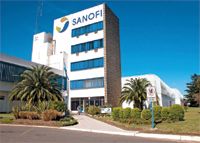
Sanofi's plant in Mirador
The next step for many firms, which they are just beginning to reach, is to enter the US and EU as generics and biosimilar players. While many labs are currently FDA and EMA compliant, only a few have actually been officially certified. Eriochem is one of the few, having received its FDA certification letter in October 2014, and is currently the only national laboratory in Argentina with FDA certification for injectable products. Lab Richmond is one of those on the cusp, as the company recently built a new plant that, according the president Marcelo Figueiras, has "the latest technologies and complies with international standards required for the production of pharmaceutical products according to PIC/S GMP," and "is prepared to [be] certified by the EMA and the US FDA." Similarly, Edgardo Taraciuk, vice president of Tuteur Argentina, explains that the firm's "state-of-the-art" plant has applied for EMA certification, along with several other labs.

Francisco Molinari, CEO, Amega Biotech
Of course, among the most sophisticated laboratories in the country are the 17 plants owned by multinationals. Despite the economic and political risks that have discouraged many foreign companies from investing in the country, the excellence of Argentinian scientists, chemical engineers, and other professionals has convinced several firms to develop or acquire plants in the country that supply their regional or global operations. Among these firms are Sanofi Pasteur, AstraZeneca, Glenmark, Catalent, GSK, Pfizer, and others. Eduardo Neira, country president for AstraZeneca, explains that the company's Argentinian facility produces "many injectables and everything related to the anaesthesia line," as well as "different types of ointments and creams," in addition to several other products manufactured in the country via a third party. Glenmark's global oncology business is actually based in Buenos Aires, which "serves as the hub for development, manufacture and distribution of injectable oncology drugs for the entire organization," according to country manager Carlos Grzelak.

Hugo Sigman, CEO, Grupo Insud
AN INNOVATIVE MODEL FOR INNOVATION
What is Argentina's biggest barrier to true innovation? "Argentina doesn't have enough capital to adequately invest in R&D without taking unreasonable levels of risk," says Mauro Bono, President of Savant, "although we arguably have the required scientific expertise." Furthermore, most Argentinian firms have very limited access to global capital and credit markets due to the economic and political risk that foreign investors must carry. Local laboratories must face these same risks, and thus are relatively conservative in their investment projects in general, with two of the most innovative firms in the country, Gador and Bagó, investing only four and five percent of their revenue in R&D respectively. As such, in the past innovation has been limited to incremental product innovations, and process innovations on the manufacturing side.

Mauro Bono, President and Founder, Savant
These instances of innovation, as well as other more radical research projects that Argentinian firms are currently involved in, have been achieved under a unique collaborative model. Since companies are unable to fund high-risk pre-competitive research, the public sector, namely the ministry of science and technology, "has filled that gap in terms of providing significant funding for pre-competitive research," explains Federico Trucco, CEO of Bioceres. This funding is distributed through two different mechanisms: first through public research organizations including national universities and the Argentinian National Scientific Research Council (CONICET), who often collaborate closely with the private sector for R&D, and through government grants for specific projects.

Santiago Garcia Belmonte, Chairman, Biosidus
CONICET employs over 8,000 researchers, and is filing an increasing number of patents each year, with 42 applications in 2010, 79 in 2011, 93 in 2012 and 94 in 2013, with 26 percent of all patents in the field of 'health'.

Argentinian Multinationals on the Horizon?
Beyond patents, technology, and early-stage research, public organizations also provide private companies with human resources in many cases. "In general, they help us by carrying out some of our development work for us so we don't have to carry the entire load ourselves," explains Francisco Molinari, CEO of Amega Biotech, referring to national universities, such as the National University of Litoral and National University of Cordoba, two organizations that they currently have projects with. In return for this assistance, Amega "helps them with their research strategy and provides them with certain technology or biological samples."
Eriochem is leading a particularly intriguing project at the moment, for which they have enlisted the assistance of Amega Biotech and the National University of Litoral. Antonio Bouzada, president and founder of Eriochem, explains that the "idea relies on the fact that many types of cancer tumors preferentially absorb a particular cholesterol lipoprotein as they grow due to a mutation on one of their receptors." Eriochem is "seeking to imitate this lipoprotein using biotechnology, which is the step that Amega Biotech is helping with, so that we can then attach a chemotherapy drug to it, our leading candidate being docetaxel." There have also been recent initiatives to stimulate and facilitate collaboration in Argentina, such as the inaugural Bio Argentina event in October 2014 hosted by the chamber of biotechnology, which brought together over 900 professionals from across the industry to discuss the strategic future for Argentina's biotech industry, and serve as a platform for researchers to present research proposals to the chamber's member companies.
BOLD BIOTECH BUSINESSES
As one of the areas in which Argentina's pharmaceutical sector is more competitive globally, biotech has been the most exposed to global trends. Alfredo Chiaradia, the general director of CILFA, expects that "in terms of the type of products we export, we follow the global trend in the expectation that by 2016, half of the top-selling drugs in the world will be of biotechnological origin. In 2012, six of the twenty bestsellers were from this source," compared to only two in the year 2000. However, another key global trend, being changing regulatory standards and demands, has also had a significant effect on the structure and strategy of Argentinian biotech firms.
"Regulatory standards are increasing worldwide, so regardless of whether we choose to compete in developed markets or emerging markets, we face increasing levels of scrutiny," explains Santiago Garcia Belmonte, president of Biosidus. Francisco Molinari, CEO of Amega Biotech, agrees that "regulatory burdens on final dosage form manufacturers, in even the most unregulated markets, have increased substantially," and points out that in many cases, this has caused clients to demand "a lot of information and analysis from API producers that is pharmaceutical in nature, as they can't handle these challenges themselves. Now our clients are asking us for the 'complete solution.'"
With these new demands from their clients, both firms have had to take a new strategic direction. "Previously, we placed the most emphasis on our transgenic animal research for API production," explains Belmonte, "and in 2010, we made the decision to focus more on final-dosage forms and recombinant proteins." Amega Biotech, which operated primarily as an API producer until five years ago, has similarly become "a pharmaceutical manufacturer of a wide range of finished dosage forms." The two companies' strategies differ at this point however. Amega Biotech is working hard to enter the US and EU markets, while Biosidus's "core objective is to become the leading biosimilars in emerging markets," according to Belmonte.
